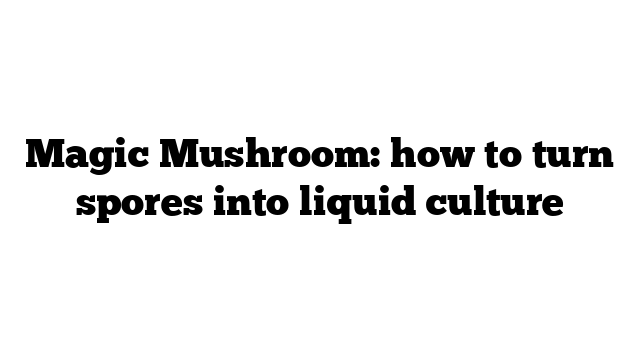Introduction
Magic mushrooms, also known as psilocybin mushrooms, have gained popularity in recent years due to their potential therapeutic benefits and mind-altering effects. Growing magic mushrooms from spores can be a rewarding and enjoyable experience, and one method to accelerate the growth process is by turning spores into liquid culture. In this article, we will discuss the process of creating a liquid culture from spores, including the necessary materials and step-by-step instructions.
What is Liquid Culture?
Liquid culture is a nutrient-rich solution that acts as a breeding ground for mycelium, the vegetative part of a fungus. It provides a more favorable environment for spores to germinate and grow, compared to the traditional method of inoculating a substrate with spores directly. Liquid culture can speed up the colonization process and increase the chances of successful mushroom cultivation.
Materials Needed
To turn spores into liquid culture, you will need the following materials:
1. Spore syringe: Obtain a spore syringe containing the desired strain. They can be purchased from reputable vendors or made at home using sterile techniques.
2. Agar plates: Agar is a gel-like substance that provides a solid surface for the spores to germinate and grow. Agar plates can be purchased or made using agar powder and other ingredients.
3. Sterile environment: It is crucial to work in a clean and sterile environment to prevent contamination. Use a laminar flow hood or a still-air box to minimize the risk of introducing unwanted microorganisms.
4. Sterilized containers: Glass mason jars or other airtight containers are suitable for holding the liquid culture.
5. Nutrient solution: Prepare a nutrient solution to promote the growth of mycelium. Common options include malt extract agar (MEA), potato dextrose agar (PDA), or a homemade recipe using ingredients like honey and water.
Step-by-Step Instructions
Now, let’s dive into the step-by-step instructions for turning spores into liquid culture:
1. Prepare the agar plates: Sterilize the agar plates according to the manufacturer’s instructions or prepare them at home using a pressure cooker. Pour the agar mixture into sterile petri dishes or containers and allow it to solidify.
2. Inoculate the agar plates: Using sterile techniques, remove the cap of the spore syringe and carefully drop a small amount of spore solution onto different sections of the agar plates. It is crucial to work quickly and ensure that the agar plates remain closed during the process to avoid contamination.
3. Allow the mycelium to grow: Incubate the agar plates at a temperature suitable for the specific strain of magic mushrooms you are working with. Typically, temperatures between 75-80°F (24-27°C) are ideal. Keep the plates in a dark and sterile environment, untouched, for several days or until you see mycelium growth.
4. Transfer the mycelium to liquid culture: Once the mycelium has grown and covers a significant portion of the agar plate, it is time to transfer it to the liquid culture. Prepare a sterile working environment, and using a scalpel or sterilized utensil, carefully cut out small sections of the mycelium-covered agar and place them into sterilized containers.
5. Prepare the liquid culture: Prepare the nutrient solution according to the chosen recipe. Sterilize the containers that will hold the liquid culture by using a pressure cooker or autoclave. Allow the nutrient solution to cool before adding it to the containers.
6. Inoculate the liquid culture: Using sterile techniques, transfer the mycelium sections from the agar plates into the containers with the nutrient solution. Close the containers securely to maintain a sterile environment.
7. Incubation and shaking: Place the containers with the liquid culture in a warm and dark environment. Incubate them at a temperature suitable for the specific strain, typically between 75-80°F (24-27°C). Shake the containers gently once or twice a day to distribute the mycelium evenly throughout the liquid culture.
8. Monitor and store: After a few days, you will notice the mycelium spreading throughout the liquid culture. Monitor its progress for any signs of contamination or abnormal growth. If all looks well, the liquid culture can be stored in a cool, dark place for future use or used for inoculating substrates.
Conclusion
Turning spores into liquid culture is an effective method to accelerate the growth of magic mushrooms. By following the step-by-step instructions outlined in this article, you can create a nutrient-rich solution that promotes the growth of mycelium. Remember to maintain strict sterile techniques throughout the process to minimize the risk of contamination. With patience and proper care, you can increase your chances of successful mushroom cultivation and enjoy the magic of growing your own mushrooms.
